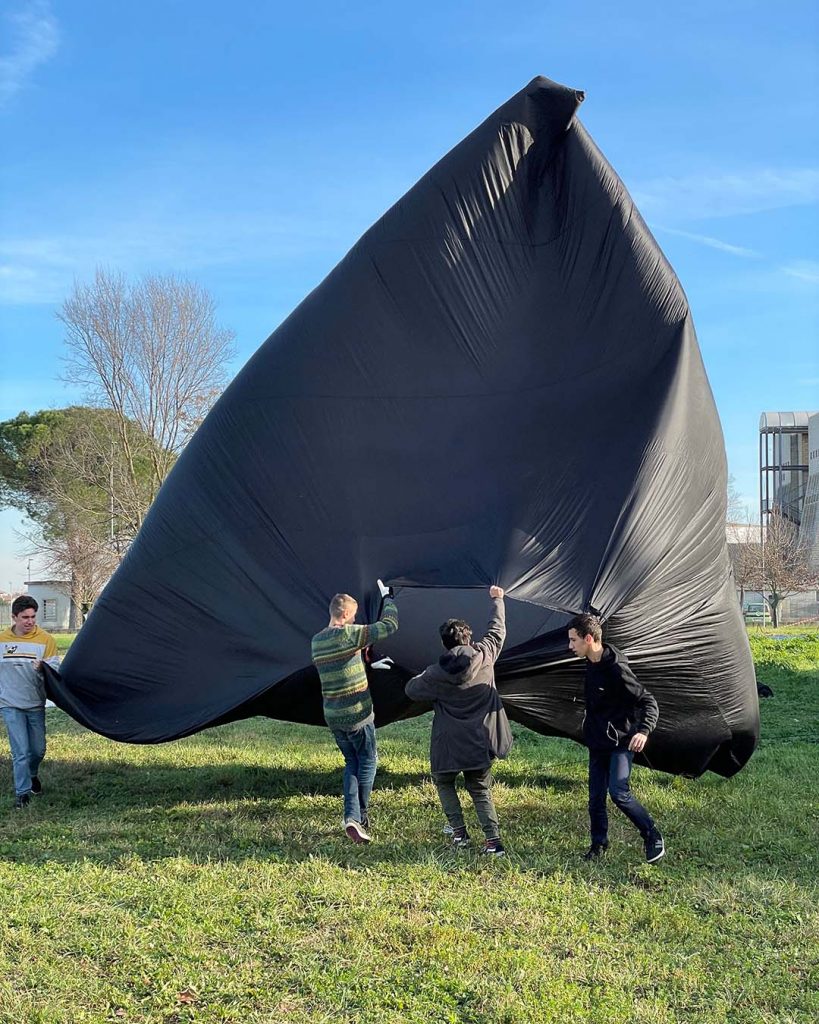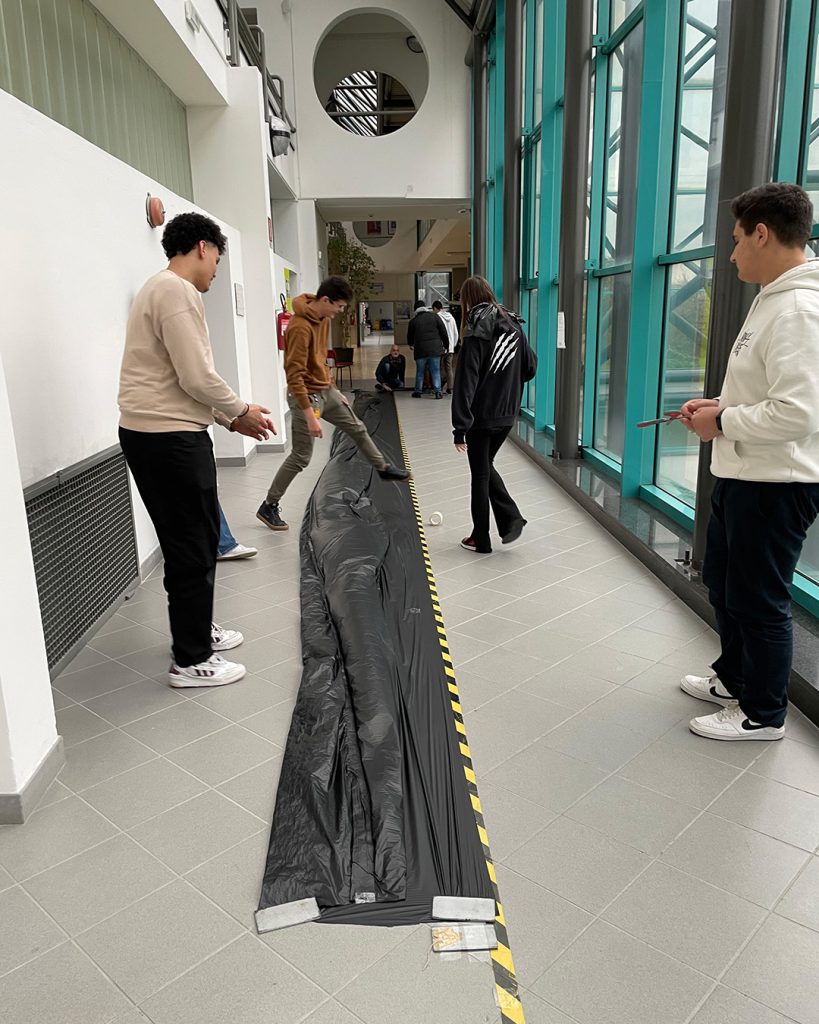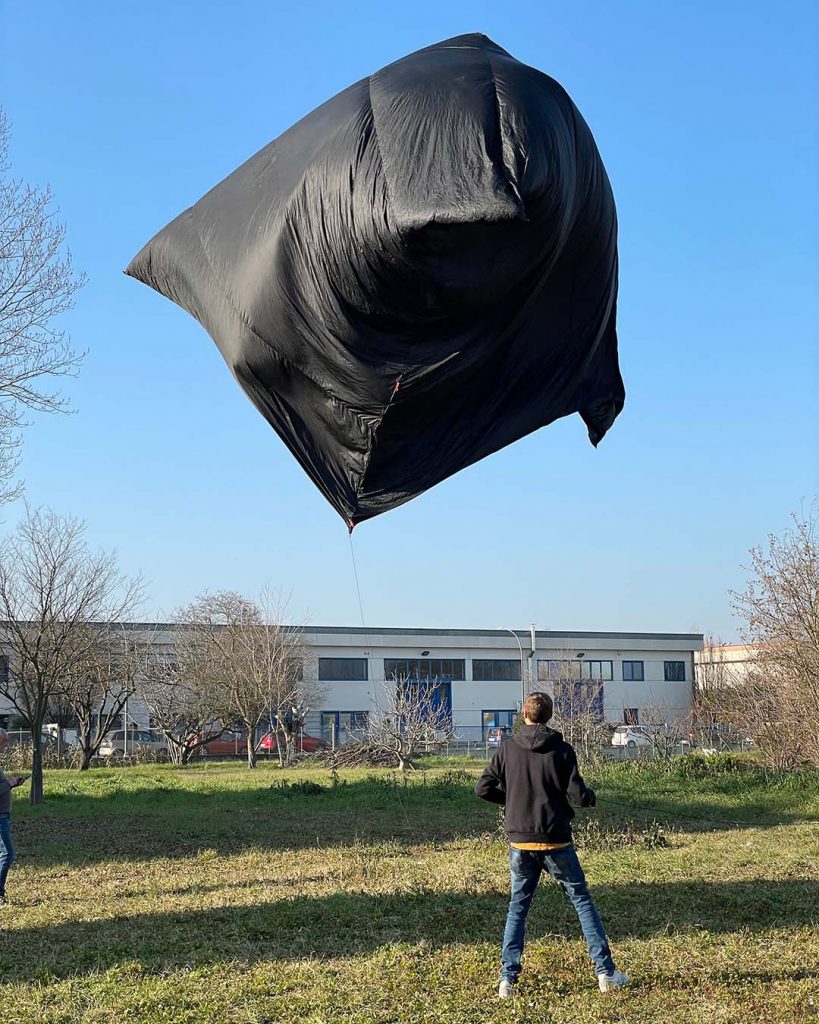Un oggetto dell'era dell'Aerocene ha sfidato gli aerei dell'Antropocene nel loro stesso territorio; è stata un'esperienza significativa per tutti i partecipanti.
Il 14 febbraio 2023, gli studenti del terzo anno hanno fatto volare la Scultura Aerocene nel cielo dell’Istituto F. Baracca di Forlì @itaerfo, uno dei tre licei aeronautici italiani, frequentato da studenti provenienti da tutta Italia con il sogno di diventare piloti o ingegneri aeronautici.
Il volo della Scultura Aerocene è stata l’ultima tappa di un corso iniziato nel novembre 2022 e progettato al confine tra arte e scienza. Gli studenti hanno imparato la fisica del volo aerosolare e hanno costruito due versioni di Tetro seguendo il manuale disponibile sul sito web di Aerocene.


Il corso è stato progettato grazie alla collaborazione tra i docenti di fisica dell’Istituto Baracca e il Dipartimento di Fisica e Astronomia dell’Università di Bologna, nell’ambito del progetto di ricerca europeo FEDORA. Insieme abbiamo progettato un corso extracurriculare per osservare cosa succede quando le conoscenze scientifiche incontrano un linguaggio artistico e per sviluppare le competenze di sostenibilità delineate in GreenComp, il quadro europeo delle competenze di sostenibilità pubblicato dalla Commissione Europea nel 2022. Il documento europeo vuole essere una guida per coloro che desiderano sviluppare progetti educativi finalizzati allo sviluppo delle competenze di sostenibilità. Il progetto artistico Aerocene è sembrato un’opportunità adeguata per raggiungere questi obiettivi educativi presso l’Istituto Baracca.
Il corso è iniziato con una lezione di presentazione delle opere di Tomás Saraceno e del progetto Aerocene, seguita da una lezione sulla fisica dei voli aerosolari e da un workshop sulla costruzione di Tetro.
In seguito, abbiamo fatto volare la scultura due volte. Il primo tentativo, il 12 gennaio, è avvenuto in una giornata di sole, ma leggere nuvole bianche hanno velato il sole e non hanno permesso alla scultura di volare con successo. Il secondo tentativo è avvenuto il 14 febbraio, nelle prime ore di un bel pomeriggio di sole, con un cielo azzurro e sgombro da nuvole. La scultura si è librata per qualche metro nello spazio aperto intorno alla scuola, a poche decine di metri dalla pista del piccolo aeroporto di Forlì. Un oggetto dell’era dell’Aerocene ha sfidato gli aerei dell’Antropocene nel loro stesso territorio; è stata un’esperienza significativa per tutti i partecipanti.
Gli studenti sono stati molto felici di sperimentare un nuovo modo di volare, totalmente diverso da quello che imparano a scuola. L’incontro con una forma d’arte è stato sorprendente ed emozionante per loro e ha offerto un’occasione unica per riflettere sul cambiamento climatico e sulla necessità di cambiare le nostre abitudini. Questa esperienza ha ampliato la loro idea di cosa significhi volare, ha fatto capire loro come possiamo collaborare con la natura e ha mostrato un modo inedito di relazionarsi con l’aria. Gli studenti hanno vissuto un’esperienza artistica che ha arricchito emotivamente la loro visione di un futuro più sostenibile, rendendo il messaggio più efficace e persistente.


Ora non resta che concludere il progetto con il test di volo delle due sculture costruite dagli studenti, non appena il sole e il vento lo permetteranno. Siamo tutti felici di aver fatto parte della comunità Aerocene. L’Istituto Baracca ripeterà l’esperienza negli anni futuri, contribuendo a far conoscere l’Aerocene e ad allargare la sua comunità.
Alla fine del corso, uno studente ha scritto: “Esprimo il desiderio che l’arte e la scienza continuino a viaggiare insieme; lavorare a questo progetto mi ha coinvolto e spero di lavorare a progetti altrettanto stimolanti in futuro”.
Ci auguriamo che altre scuole possano fare la stessa esperienza. Complimenti ad Alessandro Catania, l’insegnante che ha guidato ed elevato il progetto con l’entusiasmo dei suoi studenti e l’energia del sole.

